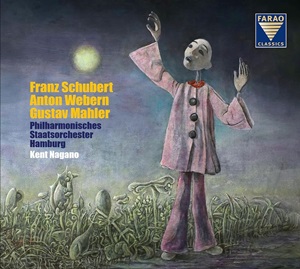
Franz Schubert (1797-1828)
String Quartet in D minor, D.810 Der Tod und das Mädchen (Death and the Maiden)
Arranged for string orchestra by Gustav Mahler (1860-1911)
Deutsche Tänze, D.820 (German Dances)
Scored for orchestra by Anton Webern
Webern (1883-1945)
Langsamer Satz für Streichquartett (Slow Movement for String Quartet) (1905)
Philharmonisches Staatsorchester Hamburg/Kent Nagano
rec. 2021 (Deutsche Tänze & Der Tod und das Mädchen), Elbphilharmonie, Hamburg, Germany; 2021 (Langsamer Satz) Laeiszhalle, Kleiner Saal, Hamburg, Germany
Farao Classics B 108116 [57]
The premises behind the eclectic programming of “song and dance” on this disc are clarified in the notes here, which are based on conversations between Farao Recording Producing Felix Gargerie, the conductor and members of the orchestra: first, that chamber and symphonic music are not necessarily “two different worlds”; the works selected here link the two genres, thereby representing an “in-between realm”. Secondly, that the apparent incongruity of associating the arch-Romantic Schubert with Mahler and Webern is justified by recognising that he was a proto-Modernist “who threw open the gates to a new chapter in music history.” Thirdly, that despite their being progressives, Mahler’s and Webern’s arrangements of Schubert’s works “express a deep longing for the past.” So far so good; the most contentious assertion for me is that Schubert’s quartet “inhabits the intermediate realm between chamber music and the large-scale symphony.” I don’t see it, myself, but I am no musicologist and Nagano maintains that it is Mahler’s recognition of that which drew him to make a symphonic arrangement of it.
All of which is quite interesting, but of secondary importance to the question whether the programme pleases. Whenever I see transcriptions of famous works, a little voice in my head asks, “Why? Do they really add another dimension of enjoyment?” Far be it from me to demur at the judgement of a great musician and a genius such as Nagano and Mahler respectively, but I can only report that my instant response to the opening chords of Schubert quartet is a decided “No”; I instantly find the textures ploggy and lacking the bite only a string quartet can provide. The adaptation imparts a kind of “smoothification” to the music which reminds me of Karajan at his soupiest (and I speak as a Herbert von K devotee). Weirdly, the introduction of a solo violin to play the fourth variation in the Andante con moto sounds sentimental in this context. My response has little to do with the playing or conducting – both are superb – but if I want to hear this music, I will always default to one of the many classic recordings or this recent “Recording of the Month”. Here I am either something of a hypocrite or testament to the fact that critical responses can vary according to one’s mood or the passing of time, as I was more positive about the much less well played account of the symphonic transcription of “Death and the Maiden” by András Vass on HDTT (review). Despite the slips and flaws, I found that recording of a live occasion more engaging and, well, – lively; the perfection of the Hamburg orchestra almost works against engagement. I am also increasingly intolerant of a progressively prevalent habit among conductors of audibly singing along, which Nagano does here incessantly; modern digital engineering and good quality headphones invariably pick this up all too easily and it is both irritating and distracting.
The most successful movement is the finale which scurries along manically; the tragic Prestissimo conclusion in D minor is thrilling and its intrinsic musical content automatically lends excitement – but I would still sooner hear the thwack and thrum of the individual instruments comprising a string quartet as they lean into it.
Nagano characterises the specific sonority of the Hamburg orchestra as having “the warmth of light” – many-coloured and flexible rather than “fiery”. This is quite true, but only confirms and compounds my impression that their sound does the music no great service.
The other Schubert works here are Webern’s transcriptions of the six short, German Dances, each lasting no more than a minute or two. They are charming, displaying a pleasing variety of orchestration, but surely not per se “major” music – just bon-bons.
Sandwiched somewhat incongruously between the two Schubert items is the Webern Langsamer Satz, beautifully, flawlessly played – an absolute gem – rising to an ecstatic climax then fading into the ether. It is perhaps significant that this is the only one of the three works here not the result of transcription, hence played as the composer intended it to be heard. It is also notably far removed in mood from the supposed “song and dance” theme. It is glorious – but I cannot really endorse a disc for ten minutes of music in what is already quite short measure at 57 minutes.
Ralph Moore
Buying this recording via a link below generates revenue for MWI and helps us keep free access to the site


Quartet for the Langsamer Satz:
Konradin Setzer (first violin)
Hibiki Oshima (second violin)
Naomi Seiler (viola)
Ciara Grünwald (cello)

















